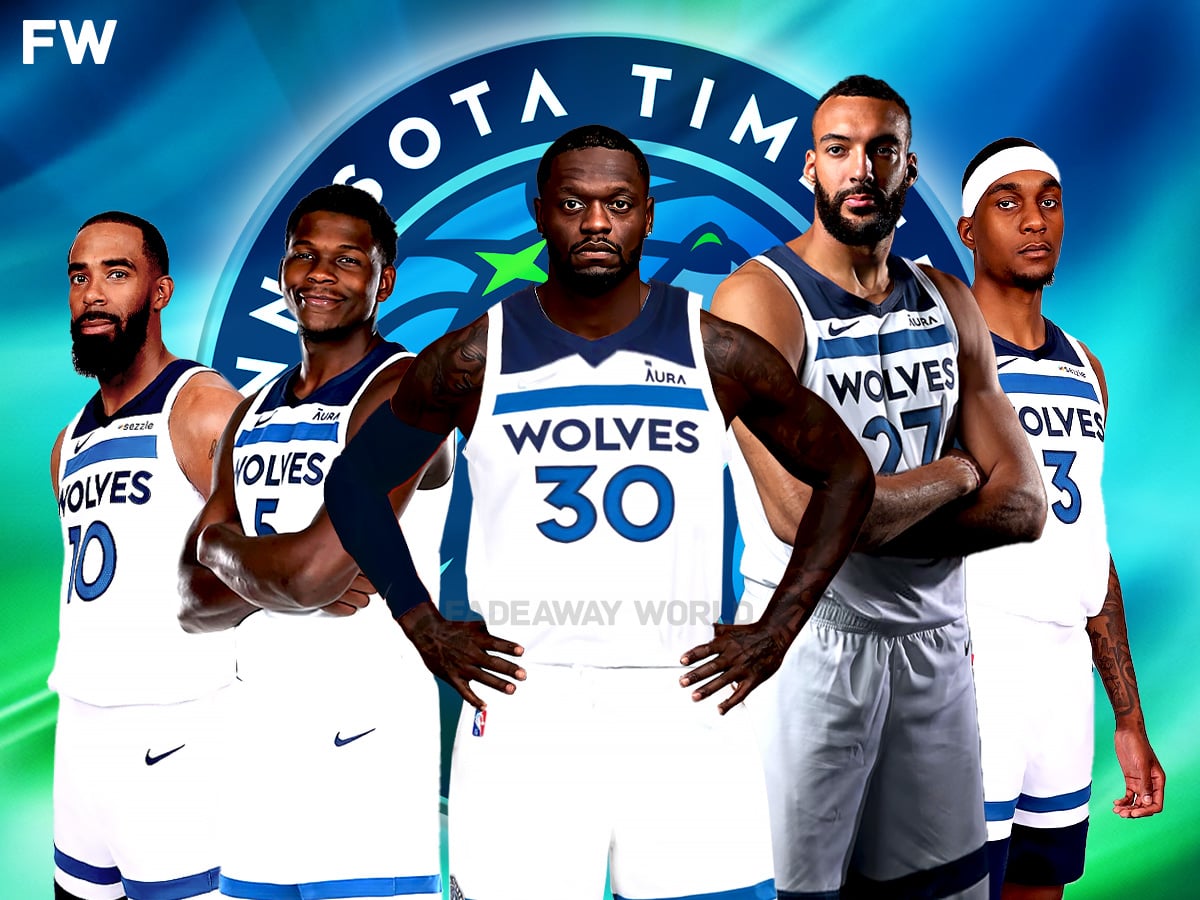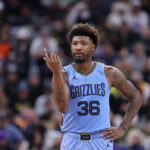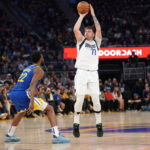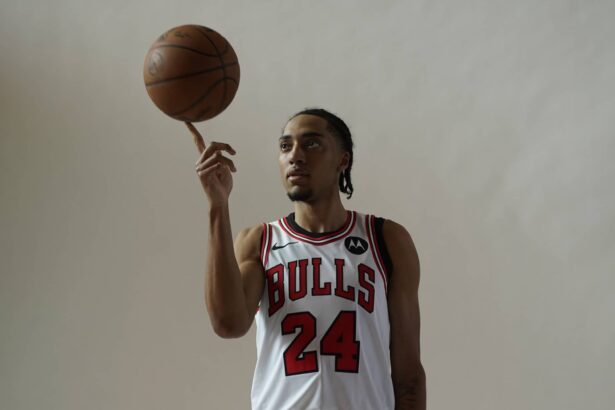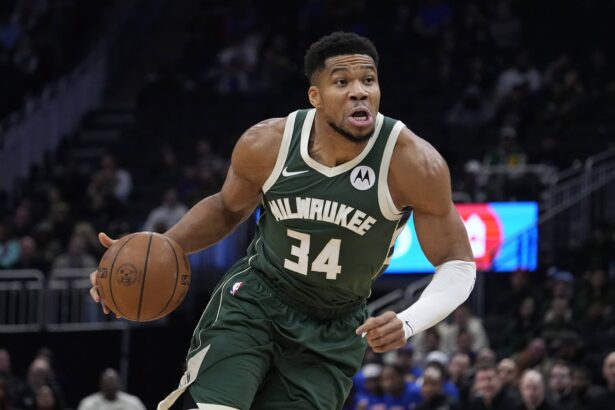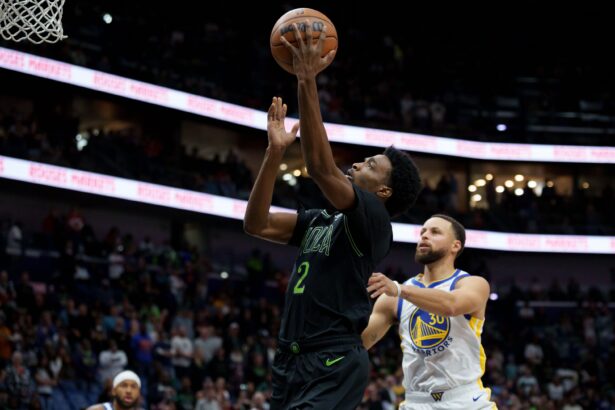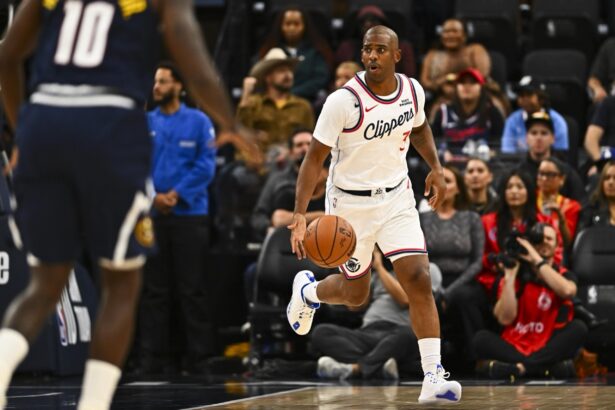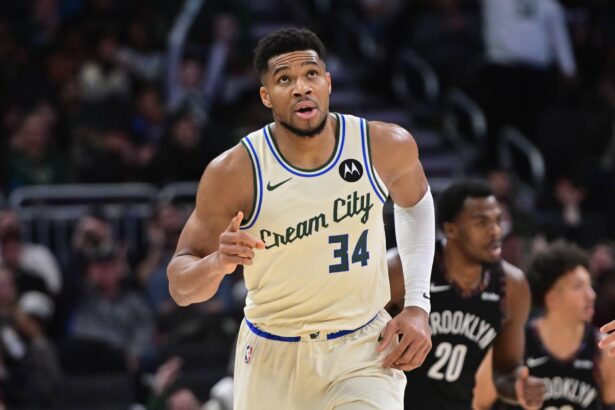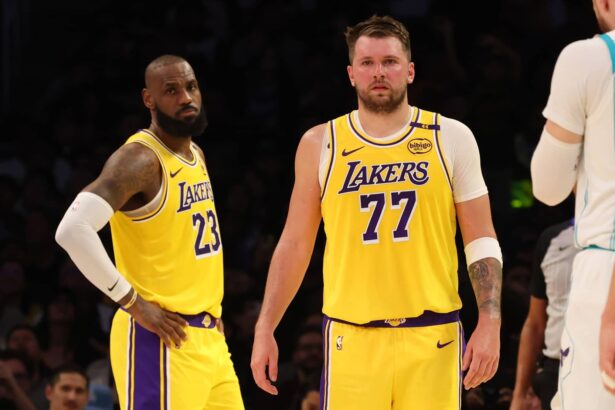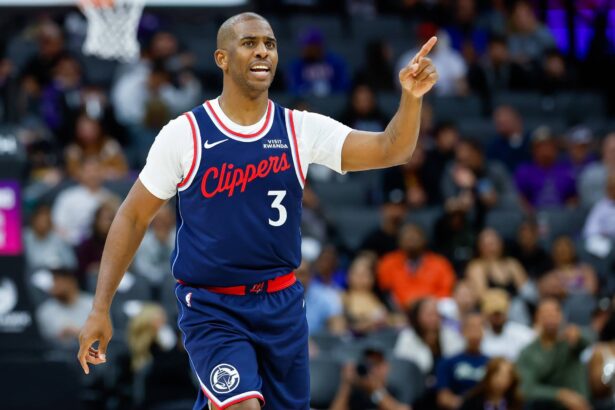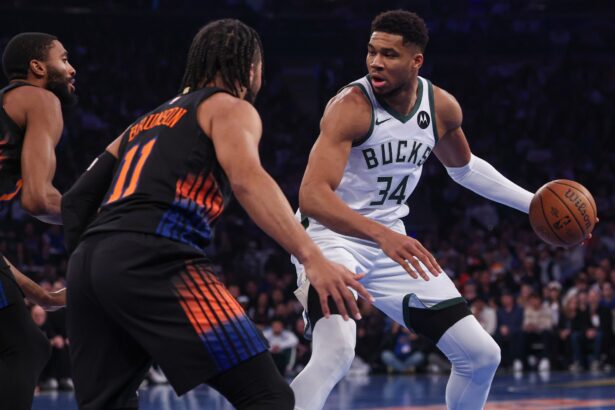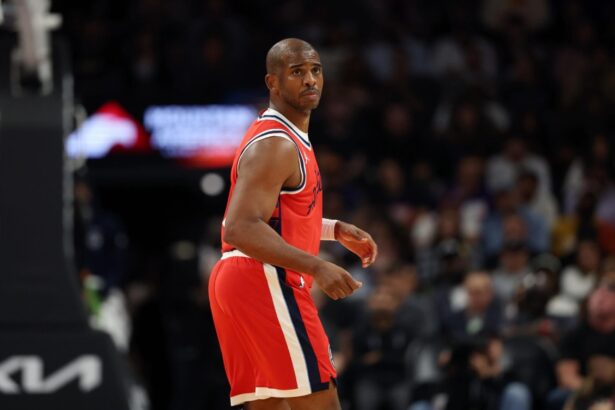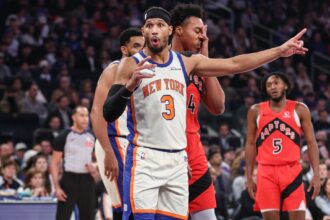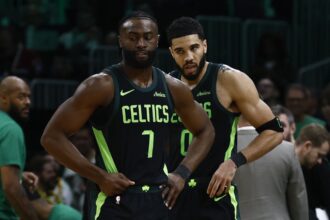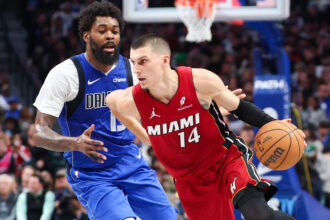The Timberwolves made one of the biggest offseason splashes, sending Karl-Anthony Towns to the Knicks in exchange for Julius Randle, Donte DiVincenzo, and a future first-round pick. While Towns was the face of the franchise for years, this trade signals a new era in Minnesota. Randle, coming off a season where he averaged 24.0 points, 9.2 rebounds, and 5.0 assists, brings a bruising style of play to the Wolves. However, his tendency for isolation ball will need to blend with Chris Finch’s system, which leans heavily on fast-paced offense and ball movement.
With the addition of Donte DiVincenzo providing perimeter shooting, the Wolves could quietly be one of the deepest teams in the West, primed for a run. At the same time, if Randle fails to adjust to the Wolves’ system, their long-term plan could be in danger, as trading Towns after reaching the Conference Finals seems like a big loss.
1. Figuring Out The Spacing
One of the biggest reasons Karl-Anthony Towns and Rudy Gobert managed to coexist last season was due to Towns’ ability to stretch the floor, creating much-needed spacing in the Timberwolves’ offense. Towns is perhaps the best shooting big man in the league, hitting 41.6% from beyond the arc in 2023-24. His perimeter threat allowed Gobert to operate in the paint, where he excels as a dominant rebounder and rim protector, while still keeping defenses honest. The pairing helped the Timberwolves maintain an offensive flow, especially when they leaned on Naz Reid for spacing off the bench, who shot an impressive 41% from three.
Now, the dynamic changes significantly with Julius Randle stepping in for Towns. Randle’s game, while effective, is much more reliant on isolation plays and mid-range jumpers. Last season, Randle struggled to find consistency from deep, shooting 31% from three. This presents a potential challenge, as Randle won’t command the same defensive respect from beyond the arc, potentially clogging the paint for Gobert and limiting his effectiveness.
The good news is that Randle is a versatile scorer who can punish mismatches in the post and is excellent at drawing fouls. His ability to bully smaller defenders could help the Timberwolves diversify their offensive sets, but the key will be balancing that with the need to maintain floor spacing. If Randle can improve his shooting, or if the Timberwolves can stagger his minutes with Gobert’s to avoid congestion in the paint, there’s potential for the offense to thrive.
Head coach Chris Finch has a challenge on his hands. The Wolves’ offense under Finch has been predicated on fast-paced ball movement and spreading the floor, which Randle’s style may not fit perfectly into. To make it work, the team will have to rely more on their other shooters, such as Anthony Edwards and DiVincenzo, to keep defenses from collapsing on Randle and Gobert.
The Wolves also have a valuable weapon in Naz Reid, whose shooting from the bench could open up more space if Randle struggles to find his range. With a revamped lineup, the Timberwolves’ depth might be the key to managing these spacing issues. While Randle may not be the perfect fit in terms of shooting, his offensive versatility offers new dimensions that Finch could exploit in the right system.
2. Who Comes Off The Bench?
The decision to trade Karl-Anthony Towns to the Knicks was about more than just getting Julius Randle in return. The Timberwolves were essentially betting on their young core—especially Naz Reid and Jaden McDaniels—who have shown tremendous potential but were financially difficult to retain with Towns’ massive contract. With Towns set to make nearly $50 million a year, keeping him meant potentially losing Reid, who shot 41.4% from three and earned Sixth Man of the Year honors last season.
Since Towns is gone, Reid has a real chance to step into a bigger role. His performance in the 2024 playoffs, where he hit a Timberwolves playoff record seven threes in a single game, showed that he can be more than just a backup big. In contrast, Towns struggled at times with foul trouble, and Reid’s ability to stretch the floor while providing rim protection makes him a perfect fit for Chris Finch’s system.
This brings us to the dilemma with Julius Randle. If the Wolves commit to Reid as their starting power forward alongside Rudy Gobert, Randle would naturally become the sixth man—a role that seems off for someone making $29 million. Randle averaged 24.0 points, 9.2 rebounds, and 5.0 assists last season before an injury, but his 31% shooting from deep complicates his fit in a team that needs spacing.
If Randle is relegated to the bench, it raises questions about the value of this trade. Swapping a perennial All-Star like Towns for a player who might not even start, and a role player like Donte DiVincenzo feels like a downgrade on paper. DiVincenzo’s elite 40.1% three-point shooting certainly helps, but is that enough to justify the deal? The Wolves are betting that Reid’s continued development, paired with Randle’s offensive punch off the bench, will make this trade worthwhile.
But paying Randle almost $30 million to come off the bench seems like a steep price. If Reid can sustain his strong play and Gobert continues to dominate defensively, it might make more sense for Randle to be the primary scorer for the second unit. Yet, given the cost and the high expectations from the trade, it could feel like a letdown if Randle isn’t a core starter, leading some to view this as an underwhelming return for Towns.
3. What The Starting Lineup Might Look Like
The most likely starting lineup for the Timberwolves this season would feature Mike Conley, Anthony Edwards, Jaden McDaniels, Julius Randle, and Rudy Gobert. This setup provides a mix of veterans, elite defense, and multiple scoring options, but there will need to be substantial adjustments to incorporate Randle effectively without compromising the flow of the offense.
Randle’s playstyle is predicated on isolation in the mid-post and elbow, where he thrives at bullying defenders, either finishing at the rim or kicking out to shooters. The problem arises with Rudy Gobert clogging the paint. Gobert’s lack of offensive versatility outside the paint could make it difficult for Randle to totally operate in his favorite spots. Randle was great at scoring, rebounding, and playmaking before his shoulder injury, but his lack of three-point efficiency makes him less ideal for spreading the floor.
A potential solution is staggering Randle and Gobert’s minutes, allowing Randle to play with floor-spacers like Naz Reid. This would open up driving lanes and give Randle more room to work in isolation. Jaden McDaniels, another key piece of the starting five, can help by spacing the floor and being a secondary playmaker in these lineups if he shows an improvement of his outside shot.
Given Randle’s limitations as a shooter, the Timberwolves may need to lean heavily on the pick-and-roll, with Mike Conley or Anthony Edwards initiating. Randle is a strong screener, and pairing him in two-man actions with either guard could create opportunities for him to dive to the rim or pop out for mid-range shots. Conley’s ability to manipulate defenses with his experience in the pick-and-roll will be crucial in creating easier shots for Randle, especially if Gobert is on the floor clogging the paint.
Anthony Edwards, who is blossoming into a superstar, will likely take over much of the offense. The team could run more Edwards-Randle pick-and-rolls, allowing Edwards to attack downhill while Randle acts as a safety valve for mid-range jumpers or post-ups. The Wolves need to find the balance between running actions for Edwards and still giving Randle enough isolation touches to stay engaged.
If the Wolves want to maximize Randle’s effectiveness, they’ll need to increase their three-point attempts. Donte DiVincenzo, acquired in the Towns trade, shot 40.1% from three on high volume and will be key in providing the spacing necessary for both Randle and Gobert. Expect more off-ball movement from the wings and an increased emphasis on getting shooters open looks from beyond the arc.
Without Towns, who provided elite spacing at the center position, the Wolves must now rely on players like DiVincenzo, McDaniels, and even Reid to hit threes consistently. This shift in offensive philosophy will allow them to keep defenses from collapsing on Randle and Gobert in the paint.
To adjust to having Randle instead of Towns, the Timberwolves might explore more small-ball lineups with Randle at the center position. This would allow them to maintain spacing without sacrificing too much size, as Randle is a strong rebounder and can hold his own in the post. With Randle at the five, the Wolves can surround him with shooters and play a faster, more up-tempo style that suits both Edwards and Conley.
Additionally, staggering Randle’s minutes with Gobert would allow the team to have a more traditional center lineup when necessary, and a spacing-oriented one when they need more offensive versatility. Running Reid-Randle lineups could be a smart move to provide extra spacing and avoid paint congestion.
Ultimately, the Timberwolves will need to fine-tune their offensive system to get the best out of Randle while keeping their defense strong with Gobert anchoring the paint. Adjusting the team’s shot distribution, incorporating more ball movement, and increasing the volume of three-pointers will be crucial for their success this season.
4. True Expectations For The Revamped Timberwolves
The Timberwolves are facing a pivotal season after trading away Karl-Anthony Towns and bringing in Julius Randle and Donte DiVincenzo. The move signals a change in strategy, with the team aiming to maintain competitiveness while retooling around their core of Anthony Edwards, Rudy Gobert, and rising star Naz Reid. So, what should fans realistically expect from this revamped squad?
The big question is whether this trade actually improves the Timberwolves or sets them back. On the one hand, Towns’ departure means losing an elite shooting big man who provided excellent spacing. His ability to score from beyond the arc forced defenses to respect him on the perimeter, which opened up driving lanes for Edwards and freed up Gobert inside.
Randle, while a high-volume scorer, doesn’t offer the same level of spacing. His three-point shooting from last season pales in comparison to Towns, and pairing him with Gobert in the starting lineup could lead to more congested offensive sets. However, Randle brings a unique skill set that Towns didn’t. His ability to bully smaller defenders in isolation and create his own shot in the mid-post is something the Wolves can use, especially in half-court situations.
If Randle’s isolation-heavy style meshes with Minnesota’s offense, which is already heavily reliant on Edwards’ shot creation, the Wolves could still be a top team in the Western Conference. Edwards is expected to take another leap after averaging 25.9 points per game last season, and pairing him with Randle could create an inside-out dynamic that defenses will struggle to handle.
Defensively, the Timberwolves should still be solid. Gobert remains one of the league’s top rim protectors, and Jaden McDaniels is emerging as one of the better perimeter defenders in the NBA. McDaniels’ length and versatility allow him to guard multiple positions, and his presence alongside Gobert in the frontcourt gives Minnesota one of the better defensive duos in the league. Adding Randle, a physical defender who can switch onto larger players, helps the team remain tough inside.
The challenge, however, will be balancing offense and defense. While Gobert locks down the paint, his offensive limitations may force the Wolves into predictable sets. This is where DiVincenzo’s shooting and McDaniels’ development as a scorer will need to come into play to complement Randle and Edwards.
In terms of overall expectations, the Timberwolves should remain a playoff contender. Their depth is improved, and the combination of Edwards’ rise to stardom, Reid’s expanded role, and Gobert’s defensive presence gives them a solid foundation. Still, their ceiling depends largely on how well Randle fits within their system.
At best, this team could return to the Western Conference Finals or beyond if Randle meshes well with Edwards and they can figure out the spacing issues. At worst, they could struggle with offensive stagnation, and the lack of consistent outside shooting from their bigs could lead to spacing problems that hurt their efficiency.
Overall, the Timberwolves should still be considered a playoff team, but their true potential will hinge on how quickly they can adapt to this new iteration of their roster. A solid top-six finish in the Western Conference is a reasonable expectation, but cracking the top tier of contenders will require everything to click—particularly between Randle, Edwards, and Gobert.

